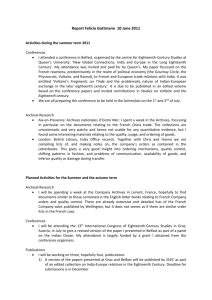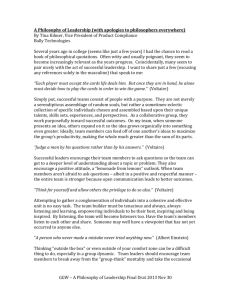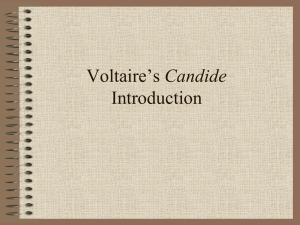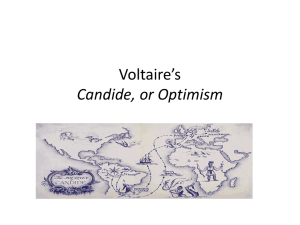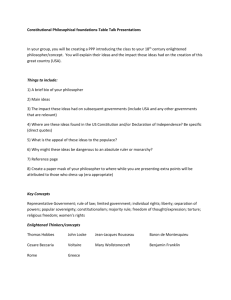A Conversation with Orion
advertisement
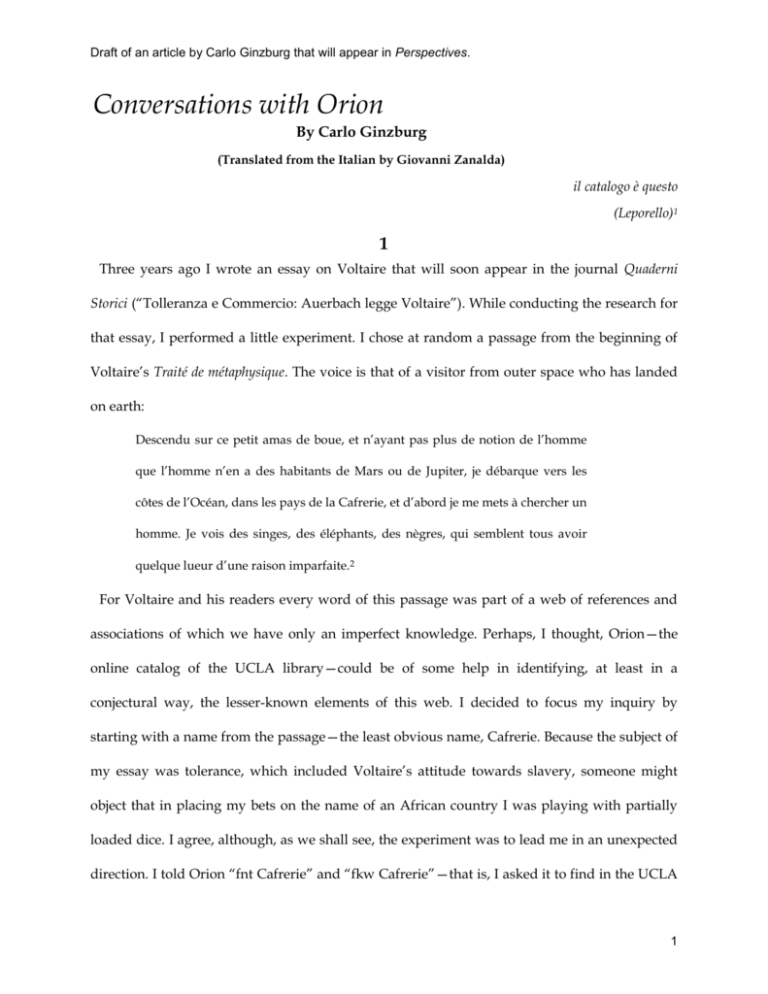
Draft of an article by Carlo Ginzburg that will appear in Perspectives. Conversations with Orion By Carlo Ginzburg (Translated from the Italian by Giovanni Zanalda) il catalogo è questo (Leporello)1 1 Three years ago I wrote an essay on Voltaire that will soon appear in the journal Quaderni Storici (“Tolleranza e Commercio: Auerbach legge Voltaire”). While conducting the research for that essay, I performed a little experiment. I chose at random a passage from the beginning of Voltaire’s Traité de métaphysique. The voice is that of a visitor from outer space who has landed on earth: Descendu sur ce petit amas de boue, et n’ayant pas plus de notion de l’homme que l’homme n’en a des habitants de Mars ou de Jupiter, je débarque vers les côtes de l’Océan, dans les pays de la Cafrerie, et d’abord je me mets à chercher un homme. Je vois des singes, des éléphants, des nègres, qui semblent tous avoir quelque lueur d’une raison imparfaite.2 For Voltaire and his readers every word of this passage was part of a web of references and associations of which we have only an imperfect knowledge. Perhaps, I thought, Orion—the online catalog of the UCLA library—could be of some help in identifying, at least in a conjectural way, the lesser-known elements of this web. I decided to focus my inquiry by starting with a name from the passage—the least obvious name, Cafrerie. Because the subject of my essay was tolerance, which included Voltaire’s attitude towards slavery, someone might object that in placing my bets on the name of an African country I was playing with partially loaded dice. I agree, although, as we shall see, the experiment was to lead me in an unexpected direction. I told Orion “fnt Cafrerie” and “fkw Cafrerie”—that is, I asked it to find in the UCLA 1 Draft of an article by Carlo Ginzburg that will appear in Perspectives. catalog books with the word “Cafrerie” in “title” or “author” (the field codes “fnt” and “fkw” meaning, respectively, “find name and title” and “find keywords”).3 In both cases there was no match for my search. I tried again the word “Cafres.” I got thirteen hits. Chronologically, the oldest was Jean-Pierre Purry, Mémoire sur les Pais des Cafres, et la Terre de Nuyts, par raport à l’utilité que la Compagnie des Indes Orientales en pourroit retirer pour son Commerce (Amsterdam 1718). This title made me curious; the author was perfectly unknown to me. I looked for the book on the shelves, and found a photocopy of the original edition. It was bound together with another text (a photocopy as well) by the same author, entitled Second Mémoire sur le Pais des Cafres, et la Terre de Nuyts (Amsterdam, 1718). Shuffling through the pages of the book, it struck me that the author, no doubt a supporter of European colonial expansion and most likely a Protestant, might be an ideal test case for Max Weber’s thesis on the Protestant ethic and the spirit of capitalism. About 10 minutes had elapsed since the title of the first Mémoire had come up on Orion. I returned to Voltaire. The idea that Voltaire might have read Purry had slipped my mind. I could not wait to begin working on Purry himself. And, indeed, I did work on him. An initial report has recently been published in the proceedings of a conference on globalization held in Istanbul.4 I am currently working on a larger version that I hope will turn into a short book. I shall not undertake to present here an abbreviated version of the provisional results of my research. (Suffice it to say that the idea of testing Weber’s hypothesis has become more complicated in the process.) What is of interest here is the mechanism that triggered my investigation. 2 The mechanism or, better, mechanisms. My initial purpose was to identify, using some guesswork, the intellectual context shared by Voltaire and his readers, but I soon started 2 Draft of an article by Carlo Ginzburg that will appear in Perspectives. another search. In retrospect, I think this change of perspective was inevitable. Voltaire’s works and correspondence fill up whole shelves; we know a great deal about his biography, his readings, and the majority of his correspondents. Rather than wasting even a few minutes of my time searching through the catalog with no particular direction, I should have worked on this extensive body of documents. If instead my purpose had been to demonstrate the efficacy of random probing, I should have focused on less well-known figures. Orion had immediately offered me the opportunity to try this out. Or was it I who had sought it out? Both the title and the author I had set out to search were unknown to me. This is a fact (Tatsache) from which other verifiable facts can be inferred, beginning from the first and most obvious one: the physical existence of the book itself. Furthermore, my reading of Purry’s Mémoires had caused still more elements to emerge, also in need of verification. It is well known that any historical inquiry proceeds more or less in this fashion. Much less obvious is the idea of deliberately creating a stage—which can be extremely short—leading from the chance encounter with a piece of evidence to the formulation of the first research hypotheses. The context shared by Voltaire and his readers, which I set out to probe, was (as Simona Cerutti pointed out to me, referring to the terminology used by the American linguist Kenneth L. Pike) an emic context, that is, one formulated in the language of actors, not in the external language of the researcher. But it was Weber’s essay on the Protestant ethic that drew me to one of the titles on the screen, Purry’s Mémoires. This was an intuition grounded in research, hence in an etic context. It is precisely in this dialogue between emic and etic perspectives, that I can see the richness of Pike’s distinction. This aims at sensitizing us to the difference between two levels that are often confused in research; it does not force us to make a choice between the two.5 To paraphrase a famous motto, I am tempted to say that, without the etic element, research is blind, without the emic, it is empty. In other words, the questions we ask from 3 Draft of an article by Carlo Ginzburg that will appear in Perspectives. documents do not emerge spontaneously from the documents themselves, even less so from catalogs. However, online catalogs do provide room for the emic context because they arrange clusters of data not mediated (that is, not contaminated) by any preexisting categories of research. Had I used a catalog by subject, I would have looked for entries such as “slavery,” “colonialism,” “imperialism.” The online catalog has allowed me to call up on the screen a random set of titles, owned by UCLA library, containing the word “Cafres.” Had I begun with a common word—for instance, “singes” or “lueur,” to stick to the same passage by Voltaire—the outcome would have been even more heterogeneous. The computer multiplies the possibilities that an unforeseen fact will take us by surprise. But is this surprise intellectually fruitful? And if so, why? The answer to the first question will come only from concrete results obtained with the research strategy I have been describing. Here I shall try to answer the second question by elucidating the premises underlying random choice. This takes for granted the crucial relevance of the etic questions posed by the researcher to the documentation. But it also complicates the dialogue by introducing emic elements of disturbance: unforeseen facts that are not the subject of research and whose existence is all but suspected. Thus, one of the premises of this research strategy is, in the first instance, to bypass, though only momentarily, the premises of the research itself. The online catalog, if properly questioned, plays the role of the devil’s advocate. What we get may initially seem puzzling. Yet, this bewilderment will only last for a minute. Generally, premises (in particular, ideological premises) immediately regain control of the situation. However, we still have to deal with the unforeseen question raised by random choice.6 Like in chess, openings in research are important, at times decisive; in any event, they have a lasting influence. The responsibility of the researcher begins here. Ancient philosophers have taught us that wonder—surprise—generates knowledge. Modern 4 Draft of an article by Carlo Ginzburg that will appear in Perspectives. interpretations of this theme have highlighted the role of estrangement, which may help attain less superficial knowledge.7 Random choice, our engine of research, can be compared to Max Ernst’s frottages: images that arise from an almost random set of natural objects. The gist of this research strategy is indirectly inspired by 20th-century (especially surrealist) poetics of the objet trouvé. But as we know, the latter has ancient roots: it goes all the way from the casual image at the center of a famous anecdote reported by Pliny, to the similarly famous passage in which Leonardo taught artists to derive inspiration from spots of humidity on the wall.8 The spot on the wall is equivalent to the title that came up on the screen of the online catalog. As Erich Auerbach wrote half a century ago, in a world like ours, which knowledge can no longer control, research should not proceed from broad conceptual categories but from concrete starting points (Ansatzpunkte), intuitively acquired and then thoroughly investigated: concrete points and, I would add, random.9 But of course I do not regard this as a rule. 3 Siegfried Kracauer, in a chapter of the posthumous book containing his incomplete reflections on history (History: The Last Things before the Last), compared the historian’s craft to that of the photographer. Kracauer was anything but a positivist. For him, photography was not synonymous with passive recording, as the cliché would want it. The photographer, like the historian, is “at once passive and active,” since he/she “records and creates” at the same time.10 As participants in the half-shaped world of everyday experience, photographic and historical realities are in part structured and in part amorphous (which Kracauer labeled, referring to Husserl, Lebenswelt). Both photographers and historians deal with intrinsically contingent materials: random events are what snapshots are made with.11 The implicit identification of snapshots as the ultimate photographic genre is not surprising for someone like Kracauer, who theorized filmmaking as a form of redemption of physical 5 Draft of an article by Carlo Ginzburg that will appear in Perspectives. reality. What I said thus far about the relevance of randomness in the interaction with documents can be read as a development of Kracauer’s analogy between the historian and the photographer. The historian roaming through catalogs, either electronic or card files, is not too different from a photographer wandering about the city and taking snapshots of a contingent, transient reality. Leo Spitzer used the word “click”—the click of a camera—to define the intuition of the critic who suddenly catches the meaning of a text read many times over. Anybody familiar with Henry Cartier-Bresson’s or Robert Capa’s photographs (here I could add other names to the list) knows that behind the click of the shutter there is memory, choice—in a word, construction. It is the slow accumulation of experience that makes the instantaneous reaction to chance possible. In any case, the identification of a promising theme of inquiry (the snapshot) must necessarily be followed by a film. Simply put, research. Carlo Ginzburg is Franklin D. Murphy Professor of Italian Renaissance Studies at the University of California at Los Angeles. A longer version of this essay has been published in Italian in Quaderni Storici. The translator, Giovanni Zanalda, is researching early modern Italian history for a PhD at the Johns Hopkins University. Notes 1. Don Giovanni, Act I, scene 5 (“The catalog is this”). 2. Voltaire, Mélanges, preface by E. Berl, edited by J.van den Heuvel (Paris, 1961), 159–60. “Once arrived on this small mass of mud, with as little an idea of man as man has of the inhabitants of Mars or Jupiter, I land on the shore of the Ocean in the regions of Cafrerie, and I immediately start looking for humans. I see monkeys, elephants, blacks. They all seem to have a glimmer of imperfect reason.” 3. The new version Orion, Orion 2, no longer has the code “fnt.” 4. C. Ginzburg, “Küresellesmeye Yerel Bir Yaklasim: Cografya, Köleler ve Incil,” Tarih Yaziminda Yeni Yaklasimlar. Kürellesesme ve yerellesme (Istanbul, 2000), 17–39. 5. Cf.. “Saccheggi rituali. Premesse a una ricerca in corso,” seminar held in Bologna coordinated by C. Ginzburg, Quaderni Storici, n.s. 65 (August 1987), 615–36, in particular 629–30. 6. See C. Ginzburg – A. Prosperi, Giochi di pazienza, (Turin, 1975), 178–83, even though, today—in part as a reaction against a simplistic reading of Foucault, I would tend to give more weight to the likely consequences of the friction between hypotheses and empirical data. 7. C. Ginzburg, Wooden Eyes. Nine Reflections on Distance (New York, 2001), 1–23. 8. E. H. Gombrich, “The Image in the Clouds” in Art and Illusion (London, 1962), 154–69. 9. E. Auerbach, “Philology and Weltliteratur,” The Centennial Review, 13 (1969), 1–17. 10. S. Kracauer, History: The Last Things before the Last, New York 1969, 47. 11. Kracauer, History, 58. 6


